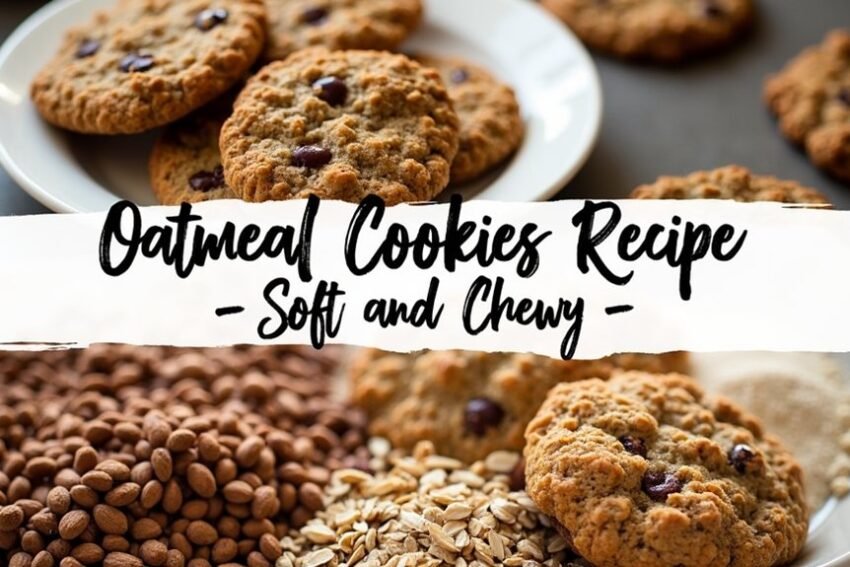Oatmeal Cookies Recipe – Soft and Chewy
Oatmeal Cookies Recipe – Soft and Chewy
You might not know that oatmeal cookies have their origins in the 19th century when oats were a popular staple in many households. When you’re looking for a soft and chewy version of these classic cookies, there are a few key ingredients and techniques that can make all the difference. For instance, the role of an extra egg yolk can enhance the texture considerably. Curious about how to achieve that perfect balance of chewiness and flavor? You’ll want to keep these tips in mind as you prepare your next batch.
Key Takeaways
- Use old-fashioned rolled oats for optimal chewiness and texture in your oatmeal cookies.
- Incorporate an extra egg yolk for added moisture and richness to your cookies.
- Combine brown sugar with granulated sugar for a softer and chewier cookie.
- Rest the dough before baking to allow hydration, enhancing the final texture.
- Aim to slightly under-bake the centers for a deliciously chewy outcome.
History
The history of oatmeal cookies traces back to 1852, when Eliza Leslie‘s cookbook, “The Complete Economical Cook,” featured one of the first written recipes combining oats with butter, sugar, and eggs. This recipe marked the beginning of a beloved treat that evolved from the traditional Scottish oatcakes, which had been enjoyed since Roman times.
Oatcakes provided quick energy boosts, serving as a convenient snack for soldiers during wartime.
Key facts to take into account include:
-
Nutritional Benefits: Oats are rich in fiber and essential nutrients, making oatmeal cookies suitable for those with allergies to other grains.
-
Evolution: The oatmeal cookie transformed over the years, with Fannie Merritt Farmer publishing the first American oatmeal cookie recipe in 1896. Quaker Oats introduced the first cookie recipe on their packaging in 1908, significantly increasing its popularity.
-
Cultural Impact: Quaker Oats considerably contributed to the popularity of oatmeal cookies through effective marketing in the late 1800s.
Recipe
Oatmeal cookies are a delicious and hearty treat that blends the wholesome goodness of oats with the sweet indulgence of cookie dough. These cookies come in various forms and flavors, making them a versatile option for any occasion. One of the appealing aspects of this recipe is the absence of raisins, making it suitable for those who dislike them.
Whether enjoyed with a glass of milk or as a snack on their own, oatmeal cookies can easily brighten your day. The combination of oats, butter, and sugar creates a chewy texture that’s simply irresistible, while the inclusion of nuts, chocolate chips, or dried fruit provides an extra layer of flavor and texture.
To prepare these delightful treats, you’ll need some common baking ingredients that can be found in most pantries. The key to achieving the perfect balance between chewy and crispy lies in the careful measurement and mixing of the ingredients.
Follow the steps below to create mouthwatering oatmeal cookies that will surely please your family and friends.
Ingredients:
– 1 cup to 1 1/2 cups old-fashioned rolled oats
– 1 cup to 1 1/2 cups all-purpose flour
– 1 teaspoon baking soda
– 1 teaspoon baking powder
– 1/2 teaspoon salt
– 1 teaspoon ground cinnamon
– 1/2 cup to 1 cup unsalted butter, room temperature
– 1-2 cups packed light or dark brown sugar
– 1 egg
– 1 teaspoon vanilla extract
– Optional add-ins: chocolate chips, chopped nuts, dried fruit, M&Ms
Instructions:
Preheat your oven to 350°F and line a baking sheet with parchment paper. In a large bowl, cream together the butter and sugars until the mixture is light and fluffy. Beat in the egg and vanilla extract until well combined.
In a separate bowl, whisk together the rolled oats, flour, baking soda, baking powder, salt, and ground cinnamon. Gradually combine the wet and dry mixtures, mixing until just combined—be careful not to overmix.
Scoop out dough balls and arrange them evenly on the prepared baking sheet, leaving space for spreading.
Extra Tips:
For an extra chewy cookie, consider adding an additional egg yolk to the batter. Incorporating a tablespoon of molasses can improve the spices and provide deeper flavor.
It’s recommended to use old-fashioned rolled oats instead of quick-cooking oats for better texture. Feel free to experiment with optional mix-ins to customize your cookies.
Finally, be sure to measure your ingredients accurately for consistent results in your final product. Enjoy your baking!
Final Thoughts
Achieving the perfect oatmeal cookie is all about understanding the little details that make a big difference. Focus on the following tips to guarantee your cookies turn out soft and chewy:
-
Use old-fashioned oats****: They provide a chewier texture compared to quick oats.
-
Incorporate an extra egg yolk****: This adds moisture and richness.
-
Choose brown sugar****: It helps retain softness and improves flavor.
-
Rest the dough: Allowing it to hydrate boosts chewiness.
-
Bake at 350°F: This temperature guarantees even cooking.
Ingredient quality also plays an essential role. Use real, unsalted butter for the best flavor, opt for all-purpose flour, and include moderate amounts of add-ins like chocolate chips or nuts. Additionally, incorporating aged baking powder and baking soda can further enhance the fluffiness of your cookies.
Don’t forget your leavening agents and a balance of spices for depth.
For creativity, try different add-ins or spices, and consider alternatives like coconut oil. Remember to chill the dough, avoid overbaking, and store your cookies in airtight containers to maintain freshness.
With these insights, you’re well-equipped to create delicious, chewy oatmeal cookies that everyone will enjoy. Happy baking!
FAQ
Steering through the world of oatmeal cookies can raise plenty of questions, especially when you want to perfect your baking technique.
Here’s a concise FAQ to guide you.
Ingredient Choices:
-
Old-fashioned oats are preferred over quick oats to maintain texture and prevent dryness.
-
Brown sugar combined with granulated sugar provides a soft, chewy cookie with a caramel-like flavor.
-
Baking soda and powder are essential for the right rise and texture.
-
Use unsalted butter to preserve the intended flavor profile.
-
Room temperature eggs facilitate better mixing and texture in your cookies. In addition to room temperature eggs, using room temperature ingredients overall helps in achieving a smoother batter.
Baking and Cooling:
-
Preheat your oven to 350°F for even baking.
-
Bake smaller cookies for 8-10 minutes and larger ones for 10-12 minutes.
-
Cool cookies on the baking sheet for a few minutes before transferring them to a wire rack.
-
Aim for slightly under-baked centers**** for chewy results.
Storing and Variations:
-
Store cookies in airtight containers for freshness.
-
Consider adding mix-ins like raisins or chocolate chips, as variations are widely acceptable.
Use these tips to troubleshoot and improve your baking experience!




